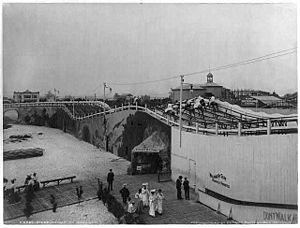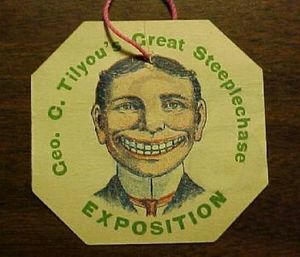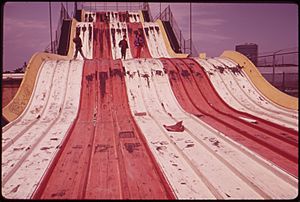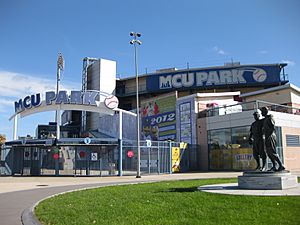Steeplechase Park facts for kids
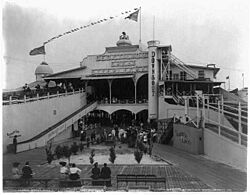
Entrance to Steeplechase Park
|
|
| Location | Brooklyn, New York, United States |
|---|---|
| Coordinates | 40°34′27″N 73°58′50″W / 40.57417°N 73.98056°W |
| Status | Closed |
| Opened | 1897 |
| Closed | 1964 |
| Owner | George C. Tilyou |
| Operated by | Tilyou family |
| General manager |
|
| Area | 15 acres (6.1 ha) |
Steeplechase Park was a 15-acre (6.1 ha) amusement park in Coney Island, Brooklyn, New York City. George C. Tilyou, a smart businessman, opened it in 1897. The park stayed open for 67 years until 1964. It was the first of three big amusement parks in Coney Island. The other two were Luna Park (1903) and Dreamland (1904). Steeplechase Park lasted the longest.
The first rides at Steeplechase Park were ones Tilyou bought in the early 1890s. They were spread out around Coney Island. In 1897, he brought them all together to create Steeplechase Park. It quickly became popular for families. A fire destroyed the park in 1907, but it was quickly rebuilt. The Tilyou family kept adding new rides, like the Parachute Jump, and the park stayed popular.
By the 1960s, Steeplechase Park started losing money. More people were going to suburban places, and the area was changing. The park closed in 1964. A developer named Fred Trump bought the land. He wanted to build homes there, but it never happened. The site was used for temporary rides in the 1970s.
Later, there was a disagreement about what to build on the land. Some wanted to rebuild the park, others wanted a sports complex. Finally, a baseball stadium called Keyspan Park (now MCU Park) was built in 2001.
Today, the Parachute Jump is the only part of the old park that remains. The New York City Department of Parks and Recreation manages the land under MCU Park. A part of Luna Park (2010) is called Steeplechase Plaza. It has the B&B Carousell and honors the old Steeplechase Park.
Contents
How Steeplechase Park Started
Steeplechase Park was created by George C. Tilyou (1862–1914). He grew up knowing a lot about Coney Island. His family ran a popular restaurant there called the Surf House. When Tilyou was 14, he started his first business. He sold boxes of Coney Island sand and salt water to tourists.
Tilyou later invested in transportation and land. In 1882, he opened Coney Island's first theater with his father. The area outside the theater became known as "Bowery Street." By 1887, Tilyou was mainly buying and selling land. He even helped fight against bad influences in Coney Island.
In 1893, Tilyou visited the World's Columbian Exposition in Chicago. He saw a huge Ferris wheel there and wanted to buy it. Since it was already sold, Tilyou built his own smaller version in Coney Island. His Ferris wheel quickly became a big attraction.
Tilyou noticed that nearby horse-racing tracks were very popular. He added more rides and attractions to Coney Island. He owned rides like the Aerial Slide and the Bicycle Railroad. But these rides were not all in one place. He decided to combine them after Paul Boyton's Sea Lion Park opened nearby in 1895. Tilyou bought and improved the Steeplechase Horses ride. This ride had mechanical horses that raced along metal tracks. This ride gave the park its name.
Park Operations
1897–1907: Early Years and Growth
Steeplechase Park officially opened in 1897. It covered 15 acres (6.1 ha) of land. The park was located at the west end of Bowery Street. Visitors entered through a large stone archway on Surf Avenue. Four stone horses decorated the top of the arch.
The park had over 50 attractions. These included the Human Niagara, a Venetian gondola ride, and a Wild West sideshow. Tilyou also had a small train, a saltwater pool, a ballroom, and a roller coaster. There were even small models of famous landmarks like the Eiffel Tower and Big Ben. In 1904, Steeplechase Pier was built, extending into the ocean.
In 1901, Tilyou looked for new rides at the Pan-American Exposition in Buffalo, New York. He wanted to bring the popular "A Trip To The Moon" ride to Steeplechase. This ride was an indoor dark ride that felt like a space flight. It was popular, but the creators decided to move it to a new park called Luna Park in 1903.
After Luna Park opened, another park called Dreamland opened in 1904. At its busiest, Coney Island had three big amusement parks. They all competed with each other. Steeplechase Park had less expensive attractions. Tilyou added fun contraptions that made people laugh and interact. The entrance had the Barrel of Love, a 30-by-10-foot (9.1 by 3.0 m) revolving drum. It would spin visitors around. Other rides included the Human Roulette Wheel and the Earthquake Stairway. These rides were designed to make people bump into each other and have fun.
Tilyou planned to sell Steeplechase Park in 1904 to build another park. But the sale did not go through. From 1905 to 1907, Tilyou added more attractions. These included a miniature railroad, a bandstand, and the Cave of the Winds.
1907 Fire and Rebuilding
On July 29, 1907, a fire started in the Cave of the Winds. It spread quickly and destroyed many wooden buildings. Firefighters worked hard to save Tilyou's house. The fire was put out in two hours, but it destroyed about 35 acres (14 ha) of Coney Island. Steeplechase Park had the most damage, estimated at $1.5 million.
Even though most of his park was gone, Tilyou stayed calm. The next morning, he put up a sign that said:
To enquiring friends: I have troubles today that I had not yesterday. I had troubles yesterday which I have not today. On this site will be built a bigger, better, Steeplechase Park. Admission to the burning ruins — Ten cents.
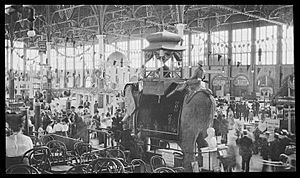
Tilyou promised to rebuild the park to be "grander than ever." The remaining attractions opened one week later. The park was rebuilt using fireproof steel and concrete. This was because a new law stopped building with wood. The rebuilding cost $2 million. By 1908, large crowds were already visiting the rebuilt attractions.
The reconstruction finished in 1909. The main attraction was the "Pavilion of Fun." This was a huge indoor area, 450 by 280 feet (137 by 85 m), covered by steel and glass. It had many indoor rides so people did not have to go outside. These included the Human Wheel and the Mixer. The old Ferris wheel was saved and placed outside. A new Steeplechase Horses ride was built around the pavilion. Admission was 25 cents. A "Combo" ticket let people go on 25 attractions.
1910s and 1920s: New Rides and Changes
Tilyou kept adding rides. He added a carousel in 1908. The "World's Largest Swimming Pool" was finished in 1909. In 1911, he opened an indoor pool. More attractions opened in 1912, including the El Dorado Carousel. Some structures from Dreamland were brought to Steeplechase after Dreamland burned down in 1911.
George Tilyou died in 1914. His children took over the park. Thomas F. McGowan became the general manager. The Tilyou family continued to own Steeplechase for another 50 years. George's oldest son, Edward, built a skating rink in 1915. A new Racing Derby Carousel was added in 1920. It had 16 rows of horses that moved up and down. Edward also added "Babyland," a play area for children. Other rides built in the early 1920s included bumper cars and the Caterpillar ride.
Steeplechase Park also started hosting beauty contests near its outdoor pool. These included the "Modern Venus" Bathing Beauty Contest and Grandma's Beauty Contest.
Some parts of the park were destroyed. The Upside-Down House burned down in 1911. Steeplechase also lost its private beach. A court ruled that the beach belonged to the state, not the park.
The Riegelmann Boardwalk opened in 1922. This led to some changes in the park's layout. The boardwalk helped increase the value of nearby land, including Steeplechase Park. The mid-1920s were a great time for roller coasters in Coney Island. Steeplechase Park built two new gravity rides called the Zip and the Limit. A water ride called the "Old Mill tunnel of love" and a Noah's Ark attraction were also built. Thomas McGowan died in 1927, and James J. Onorato took over as manager.
1930s: Great Depression and World War II
The Great Depression meant fewer people visited Steeplechase Park. However, people still came to see the beauty contests. In 1934, a bobsled roller coaster called Flying Turns was added.
Fires and accidents still happened. A fire in July 1932 caused a lot of damage. In 1933, 57 people were hurt when a balcony collapsed. In 1935, a child died after falling off the Steeplechase Horses. A big fire in September 1939 destroyed boardwalk concessions and park attractions.
The 1939 New York World's Fair also caused fewer people to visit Coney Island. After the World's Fair closed in 1940, the Tilyous bought the fair's Parachute Jump. This ride was a tall tower with parachutes. It opened in 1941 and had 12 parachutes dropping from a 250-foot-tall (76 m) tower. Other rides like rocket cars were added. During World War II, there were not enough staff. In 1945, the Pavilion of Fun had to close temporarily. The park returned to normal staffing in 1946.
1940s and 1950s: Decline of the Park
After World War II, Steeplechase Park started to decline. There were more fires and fewer visitors. In 1944, Luna Park, Steeplechase's main competitor, was damaged by fires and closed in 1946. This left Steeplechase as the only major amusement park in Coney Island.
After Edward Tilyou died in 1944, his siblings took over. They often disagreed about how to manage the park. In 1947, they stopped selling the combination ticket. They offered a pass for 15 rides for one dollar. Steeplechase also saw its 20-millionth visitor that year. New rides like the Scrambler were added in 1948.
The park continued to decline. The skating rink was torn down in 1951. Other buildings were demolished in 1952. A flood and fire in 1953 destroyed some machinery. However, the park started making money again when a TV show, Arthur Godfrey and His Friends, broadcast from Steeplechase in 1955. After Steeplechase Pier burned down in 1957, a new, larger one opened in 1958. Marie Tilyou became president of the Steeplechase Corporation in 1959. She added new rides like a Tilt-a-Whirl and a Round Up ride.
Park Closure
Robert Moses, a New York City parks commissioner, wanted to redevelop Coney Island. He wanted to replace many businesses with homes. Coney Island was seeing fewer visitors each year. More crime, not enough parking, and bad weather were some reasons. The start of the 1964 New York World's Fair also drew people away.
Despite this, Steeplechase Park had a record number of visitors in 1961, with over 18,000 people in one day. However, the park still faced problems. In 1962, the Huber family, who owned one-third of the park's land, decided to sell it. More attractions were destroyed in a 1963 fire.
By the early 1960s, George C. Tilyou's children were getting old. His last son, Frank, died in 1964. The park was now owned by four women who had different ideas for its future. Steeplechase Park closed for the season on September 20, 1964. This would be its last time.
Rumors of a sale started in February 1965. On July 2, 1965, developer Fred Trump bought the property. He announced he wanted to build luxury apartments there. Many people in Coney Island were against the sale, but it fit with the area's change to more homes.
What Happened to the Site Later
Trump's Ownership and Temporary Rides
Fred Trump planned to build a 160-foot-high (49 m) dome with recreation and a convention center. He tore down Steeplechase Park's Pavilion of Fun in September 1966. He even sold bricks to guests at the demolition to smash the remaining windows.
In October 1966, the city wanted to buy the 125 acres (51 ha) site to keep it for recreation. Trump disagreed. In 1968, the city voted to buy the land from Trump. The city bought the site for $4 million. This stopped Trump from building apartments there.
The Steeplechase Park site was empty for several years. Trump then leased the property to Norman Kaufman. Kaufman ran a small amusement park on a part of the site, also called "Steeplechase Park." The city tried to evict Kaufman because they wanted to build a state park there.
The city and Kaufman had a long legal fight. In 1977, the city suggested redeveloping the site as an amusement area instead of a state park. By 1979, Kaufman had expanded his park. He even bought back the original Steeplechase horse ride. Kaufman operated the site until 1980. In 1981, the city paid Kaufman a million dollars for the rides and finally got him to leave the property.
Building a Stadium
In the mid-1980s, a businessman named Horace Bullard wanted to rebuild Steeplechase Park. He owned land near the site and planned to spend $55 million on a new theme park. The city approved his plan in 1985. Bullard hoped to open the park by 1986.
However, the project was delayed. In 1986, the state proposed building a $58 million baseball stadium nearby. Another developer also wanted to build a sports arena on the site. Bullard and the other developers fought over the land for four years.
When Rudy Giuliani became mayor in 1994, he stopped Bullard's deal. He approved building a minor-league baseball stadium on the Steeplechase Park site. In 1998, Giuliani canceled the sports complex plans. He decided to build only a parking lot. The minor league team was called the Brooklyn Cyclones. Bullard had wanted to restore the Thunderbolt roller coaster, but Giuliani had it torn down. In 2000, the city approved the $31 million project to build Keyspan Park (now MCU Park). The baseball stadium opened in 2001.
Current Status
Most of the old Steeplechase Park site is now taken up by MCU Park. The New York City Department of Parks and Recreation owns the 10 acres (4.0 ha) of land under MCU Park. They still call it "Steeplechase Park." There is also a public plaza on the boardwalk south of MCU Park.

In November 2011, work began on a 2.2-acre (0.89 ha) area around the Parachute Jump. This area is called Steeplechase Plaza. The city also announced that the historic B&B Carousell would be moved there. The carousel opened in 2013 at Steeplechase Plaza, which is part of Luna Park. The carousel was added to the National Register of Historic Places in 2016. The plaza is next to Thunderbolt, a new roller coaster that opened in 2014.
The only building still standing from the original Steeplechase Park is the tall tower of the Parachute Jump. It was almost torn down in the mid-1900s. But it was too expensive to demolish, so it stayed. The ride stopped working in 1964. Because it was still too expensive to tear down, the tower became a New York City designated landmark in 1977. It was also placed on the National Register of Historic Places in 1980. In 1989, the Parachute Jump was again recognized as a city landmark.
Images for kids


